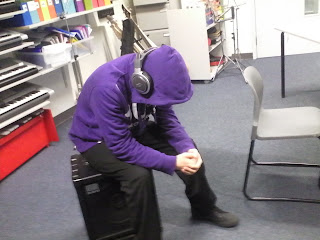Equipment: As Dubstep is created electronically without instruments I will be using electronic equipment such as a laptop. I believe that this is is appropriate as it relates back to how Dubstep tracks are made.
Clotihng: Casual clothing e.g. a t-shirt or a hodded top and huge earphone to link back to the dubstep theme.
Below are the final photographs for my magazine taken as a group:
This shows the right aspects of a dub-step related photo including headphones, DJ equipment as well as my body language suggesting that I am creating music electronically which is common within dubstep. However, The shot type used doesn't seem to suit my purpose which is to focus on the artist and this image expands out to his surroundings. As well as this, the image is blurry and is of poor quality.
This image is very similar to the first one. As can be seen, the image quality is much more clearer as well as the shot being focussed more on the artist.
This photo of Daniel holding a large speaker relates back to the power and loudness of Dubstep. His pose also suggests power adding to the impact og the photo.
Although this photo is supposed to show Daniel creating music, the angle of the camera as well as body language shows him to look more as if he is doing work on a computer.
This photo is similar to the previous one however this time, the camera angle is much higher revealing the keyboard to be an electronic piano showing that he is not doing work but is instead creating music.
Although this photo is relavent to the magazine (portraying someone listening to music),the poor image quality prevents it from being usable.
The images below and above show a link to Dubstep as they portray someone wearing big headphones however, the clothing (a shirt and tie) is not appropriate for the Dubstep genre.
This photo portrays me with my hood up and me facing down so that my head is completley covered up and unrecognisable. This reflects on the underground nature of Dubstep. As well as this, it shows me sitting on a large speaker showing a connection between me and Dubstep (as connoted by the speaker).
This photo is similar to the one of me on the decks however there are two artsits instead of one. This photo shows that even in Dubstep, two artisits can converge and make a single track together just like in other genres.
The hood up in this picture links to the urban culture of London ( the roots of Dubstep). The slight low angle shows a blend of dominance as well as significance.
The images above and below are a focus on the equipment used as I believe it is an important aspect of Dubstep.
All of the photos above shows the surroundings that I believe fit those of Dubstep artists. They mainly consist of brick walls and grafitti to relate to the urban roots of Dubstep.
These last few photos once again focus on the equipment used to create dubstep which I feel is appropriate due to my double page spread is guideing audinces on the correct equipment (a huge part of the process of creating Dubstep).





































